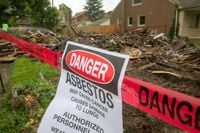The Environmental Protection Agency (EPA) under the Trump administration has announced plans to reconsider the ban on chrysotile asbestos, the last type of asbestos still legally used in the United States. This development, revealed in court documents filed on June 16, 2025, marks a significant shift from the Biden administration's efforts to eliminate asbestos use after decades of health concerns and regulatory battles.
Asbestos, a naturally occurring mineral known for its heat resistance and insulating properties, has a dark legacy. It has been widely used in construction, automotive parts, and industrial applications since the 1930s. However, exposure to asbestos fibers is linked to serious diseases, including lung cancer, mesothelioma, ovarian cancer, and laryngeal cancer. According to the EPA, asbestos exposure causes over 40,000 deaths annually in the U.S., making it a public health crisis that has spanned generations.
Chrysotile asbestos, also called “white asbestos,” is the most common form of asbestos and the only one still permitted for use in the U.S. before the recent ban. It has been used in roofing materials, textiles, cement, gaskets, clutches, brake pads, and other automotive parts, as well as in chlorine manufacturing. Despite its known dangers, chrysotile asbestos has remained in use, even as more than 50 countries worldwide have banned it outright.
In March 2024, the Biden administration finalized a ban on chrysotile asbestos, a move hailed as a “major milestone for chemical safety.” Former EPA Administrator Michael Regan emphasized the scientific consensus, stating, “The science is clear—asbestos is a known carcinogen that has severe impacts on public health.” The ban allowed companies a generous phase-out period, in some cases up to 12 years, to eliminate asbestos from their products and processes.
However, the ban faced immediate legal challenges from industry groups, including the American Chemistry Council, which argued against the regulation. Now, the Trump administration’s EPA is responding to a petition from the Texas Chemistry Council by initiating a formal reconsideration of the asbestos ban. According to court filings, the EPA intends to undertake a notice-and-comment rulemaking process expected to last approximately 30 months, during which enforcement of the ban could be effectively paused.
Lynn Ann Dekleva, the EPA’s Deputy Assistant Administrator of the Office of Chemical Safety and Pollution Prevention, who previously worked as a lobbyist and director for the American Chemistry Council, filed a declaration supporting the reconsideration. An EPA spokesperson confirmed that the agency will assess “what is necessary to eliminate the unreasonable risk” posed by asbestos and whether alternative measures, such as permanent workplace protections, could suffice instead of a complete ban.
This reconsideration could potentially allow asbestos use to resume in certain industrial applications, including chlorine production and the installation of new asbestos-containing sheet gaskets in petroleum, chemical, power production, and nuclear facilities. The EPA has acknowledged that the previous ban might have “gone beyond what is necessary” to protect public health.
Public health advocates have reacted with alarm. Linda Reinstein, co-founder and president of the Asbestos Disease Awareness Organization, called the EPA’s move a “serious setback for public health.” She warned, “EPA’s own science confirms that asbestos is deadly, even at low exposures. Each year, 40,000 Americans die from preventable asbestos-caused diseases. Workers and families cannot afford more exposure to the dangers of asbestos as a result of the EPA gutting protections it has already deemed necessary for public health.”
Asbestos fibers become airborne when materials containing them are disturbed, posing dangers especially to workers in construction, automotive, and manufacturing industries. Exposure is often invisible and can lead to disease decades later, as the fibers remain lodged in the lungs permanently. There are no treatments for asbestos-related diseases, making prevention critical.
The Trump administration’s stance on asbestos is not new. In 2018, the EPA under Trump enacted a significant new use rule allowing the manufacture of new asbestos-containing products on a case-by-case basis. Moreover, in his 1997 book, The Art of the Comeback, Donald Trump expressed skepticism about asbestos bans, claiming the movement against asbestos was a conspiracy “led by the mob,” and controversially stating that asbestos is “100 percent safe, once applied.”
Trump’s pro-asbestos position has even been embraced abroad. In 2018, a Russian asbestos company began marketing asbestos products featuring Trump’s face and a seal reading “Approved by Donald Trump, 45th President of the United States.” Russia remains a primary supplier of asbestos to the U.S.
This reconsideration of the asbestos ban comes amid broader regulatory rollbacks by the EPA under the Trump administration. The agency has also expressed interest in weakening regulations on “forever chemicals” (PFAS), reversing findings on greenhouse gas dangers, and loosening coal ash enforcement. Critics argue these moves jeopardize public health and environmental protections.
The EPA has stated it will consider all reasonably available information and adhere to the best available science in its reassessment. However, the process is expected to take over two years, during which asbestos use could potentially increase, raising concerns among health experts and workers’ advocates.
Asbestos has long been recognized as a silent killer, with exposure linked to tens of thousands of deaths annually in the U.S. The move to reconsider the ban threatens to undermine decades of progress in protecting Americans from this deadly mineral. It also raises urgent questions about the balance between industry interests and public health safeguards in regulatory policymaking.
For now, the asbestos debate remains unresolved, with the EPA’s upcoming rulemaking process set to determine the future of asbestos use in America. Meanwhile, health advocates continue to call for strict protections to prevent further exposure and save lives.





